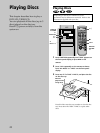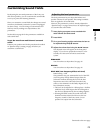
26
Playing Discs
x dts LFE MIX
(dts Low Frequency Effect mix level)
Initial setting: 0 dB
This parameter lets you attenuate the level of the LFE
(Low Frequency Effect) channel output from the
subwoofer without effecting the level of the bass
frequencies sent to the subwoofer from the front,
center, or rear channels via the “dts” bass redirection
circuitry.
• The level can be adjusted in 1 dB step from –20 dB to
+10 dB (line level).
• Selecting MUTING mutes the sound of the LFE
channel from the subwoofer. However, the low
frequency sounds of the front, center, or rear
speakers are output from the subwoofer.
z
About the level differences in the LFE MIX settings
The “dts LFE” level is set to +10 dB and “LFE MIX” (Dolby
Digital) is set to 0 dB. This is because there is an initial difference
of 10 dB in the overall mix between the Dolby Digital and dts
LFE channel levels. Essentially, with the “dts LFE” level set to +10
dB and the “LFE MIX (Dolby Digital)” level set to 0 dB,
approximately the same amounts of LFE channel signal are
distributed to the other audio channels in the overall mix.
x D.COMP. (Dynamic range compressor)
Initial setting: OFF
This parameter lets you compress the dynamic range
of the sound track.
This may be useful when you want to watch movies at
low volumes late at night.
• OFF reproduces the sound track with no
compression.
• 0.1~ 0.9 allow you to compress the dynamic range in
small steps to achieve the sound you desire.
• STD reproduces the sound track with the dynamic
range intended by the recording engineer.
• MAX provides a dramatic compression of the
dynamic range.
Note
Dynamic range compression is only possible with Dolby Digital
sources.
z
About the Dynamic Range Compressor
This parameter allows you to compress the dynamic range of the
soundtrack based on the dynamic range information included in
the Dolby Digital signal. “STD” is standard compression, but
because many sources have only light compression, you may not
notice much difference when using 0.1~ 0.9.
Therefore, we recommend using the “MAX” setting. This greatly
compresses the dynamic range and allows you to view movies
late at night at low volumes. Unlike analog limiters, the levels are
predetermined and provide a very natural compression.
Customizing Sound Fields
Adjusting the surround parameters
The surround parameters let you customize various
aspects of the current sound field. The settings available
here are stored individually for each sound field.
1 Start playing a program source encoded with
multi-channel surround sound.
2 Press AMP MENU repeatedly on the remote to
display <<SURROUND>> on the front panel display.
3 Sit at your listening position and select the item to
be adjusted using the M/m buttons.
4 Adjust the volume level using the </, buttons.
The adjusted value will appear on the front panel
display. If you do not operate the remote for a few
seconds, the value turns off and is stored in the
system.
x EFFECT (Effect level)
Initial setting: (depends on sound mode)
This parameter lets you adjust the “presence” of the
current surround effect.
x WALL (Wall type)
Initial setting: center
When sound is reflected off soft materials, such as a
curtain, the high frequency elements are reduced. A
hard wall is highly reflective and does not
significantly effect the frequency response of the
reflected sound. This parameter lets you control the
level of the high frequencies to alter the sonic
character of your listening environment by simulating
a softer (S) or harder (H) wall. The center position
designates a neutral wall (made of wood).
x REVB. (Reverberation)
Initial setting: center
Before sound reaches our ears, it is reflected
(reverberated) many times between the left and right
walls, ceiling, and floor. In a large room, sound takes
more time to bounce from one surface to another than
in a smaller room. This parameter lets you control the
spacing of the early reflections to simulate a sonically
longer (L) or shorter (S) room.
• The reverberation can be adjusted ±6 from S (short,
–6) to L (long, +6) in 13 steps.
• The center position (0) designates a standard room
with no adjustment.


















